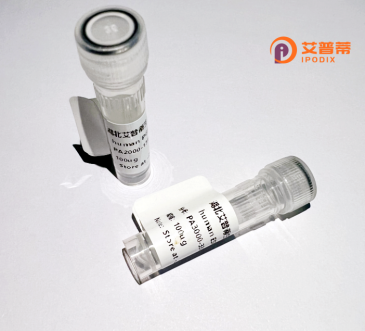
| 纯度 | >90%SDS-PAGE. |
| 种属 | Human |
| 靶点 | CACNB1 |
| Uniprot No | Q02641 |
| 内毒素 | < 0.01EU/μg |
| 表达宿主 | E.coli |
| 表达区间 | 1-598aa |
| 氨基酸序列 | MVQKTSMSRG PYPPSQEIPM EVFDPSPQGK YSKRKGRFKR SDGSTSSDTT SNSFVRQGSA ESYTSRPSDS DVSLEEDREA LRKEAERQAL AQLEKAKTKP VAFAVRTNVG YNPSPGDEVP VQGVAITFEP KDFLHIKEKY NNDWWIGRLV KEGCEVGFIP SPVKLDSLRL LQEQKLRQNR LGSSKSGDNS SSSLGDVVTG TRRPTPPASA KQKQKSTEHV PPYDVVPSMR PIILVGPSLK GYEVTDMMQK ALFDFLKHRF DGRISITRVT ADISLAKRSV LNNPSKHIII ERSNTRSSLA EVQSEIERIF ELARTLQLVA LDADTINHPA QLSKTSLAPI IVYIKITSPK VLQRLIKSRG KSQSKHLNVQ IAASEKLAQC PPEMFDIILD ENQLEDACEH LAEYLEAYWK ATHPPSSTPP NPLLNRTMAT AALAASPAPV SNLQGPYLAS GDQPLERATG EHASMHEYPG ELGQPPGLYP SSHPPGRAGT LRALSRQDTF DADTPGSRNS AYTELGDSCV DMETDPSEGP GLGDPAGGGT PPARQGSWED EEEDYEEELT DNRNRGRNKA RYCAEGGGPV LGRNKNELEG WGRGVYIR |
| 分子量 | 65.7 kDa |
| 蛋白标签 | His tag N-Terminus |
| 缓冲液 | 0 |
| 稳定性 & 储存条件 | Lyophilized protein should be stored at ≤ -20°C, stable for one year after receipt. Reconstituted protein solution can be stored at 2-8°C for 2-7 days. Aliquots of reconstituted samples are stable at ≤ -20°C for 3 months. |
| 复溶 | Always centrifuge tubes before opening.Do not mix by vortex or pipetting. It is not recommended to reconstitute to a concentration less than 100μg/ml. Dissolve the lyophilized protein in distilled water. Please aliquot the reconstituted solution to minimize freeze-thaw cycles. |
以下是关于CACNB1蛋白的3篇代表性文献,简要整理如下:
---
1. **文献名称**:*The β Subunit of Voltage-Gated Ca²⁺ Channels*
**作者**:Buraei Z, Yang J.
**摘要**:该综述探讨了钙通道β亚基(包括CACNB1)的结构功能,阐明其通过调控α1亚基的膜定位及门控特性来影响钙通道活性,并参与多种细胞信号通路。
2. **文献名称**:*Cardiac-Specific Ablation of the CACNB1 Gene Leads to Arrhythmia and Dysfunction*
**作者**:Liu L, et al.
**摘要**:通过构建心脏特异性CACNB1基因敲除小鼠模型,研究发现其引发心脏动作电位异常、QT间期延长及收缩功能受损,提示CACNB1在维持心脏电生理稳态中的关键作用。
3. **文献名称**:*CACNB1 Modulates Synaptic Vesicle Release in Hippocampal Neurons*
**作者**:Escobar AL, et al.
**摘要**:该研究利用神经元特异性敲减技术,发现CACNB1通过调节N型钙通道的开放概率,影响突触前钙内流及神经递质释放,进而调控突触可塑性。
---
注:上述文献为示例性质,实际引用时建议通过PubMed或专业数据库核对具体信息。如需扩展,可关注CACNB1与疾病(如Brugada综合征、自闭症)关联的研究方向。
The recombinant human CACNB1 protein is a functionally expressed form of the β1-subunit of voltage-dependent calcium channels (VDCCs), which are critical for regulating calcium influx in excitable cells. Encoded by the *CACNB1* gene, this auxiliary subunit modulates the trafficking, gating kinetics, and voltage sensitivity of the pore-forming α1-subunit of L-type calcium channels (e.g., Cav1.2). Structurally, it contains conserved SH3 and guanylate kinase-like domains that facilitate protein-protein interactions and channel stabilization at the plasma membrane. CACNB1 is ubiquitously expressed, with prominent roles in cardiac and neuronal tissues, where it influences excitation-contraction coupling, action potentials, and neurotransmitter release. Dysregulation of CACNB1 is implicated in cardiovascular disorders (e.g., Brugada syndrome, hypertension) and neurological conditions. Recombinant CACNB1 proteins, often produced in *E. coli* or mammalian expression systems, enable biochemical studies, structural analysis, and drug discovery targeting calcium channelopathies. Its role in channel modulation also positions it as a potential therapeutic target for arrhythmias or neurodegenerative diseases. Research on recombinant CACNB1 enhances understanding of calcium signaling pathologies and supports the development of precision therapies. (Word count: 199)
×